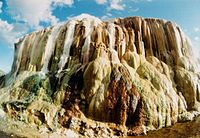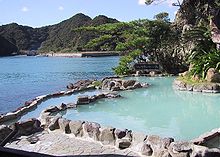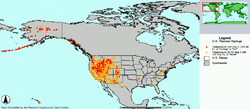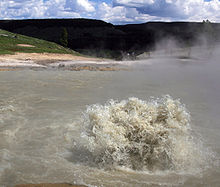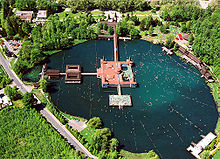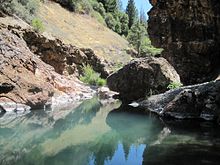- Hot spring
-
For places with similar name, see Hot Springs (disambiguation).
A hot spring is a spring that is produced by the emergence of geothermally heated groundwater from the Earth's crust. There are geothermal hot springs in many locations all over the crust of the earth.
Contents
Definitions
There is no universally accepted definition of a hot spring. For example, one can find the phrase hot spring defined as
- any geothermal spring[1]
- a spring with water temperatures above its surroundings[2]
- a natural spring with water temperature above body temperature – normally between 36.5 and 37.5 °C (98 and 100 °F)[3]
- a natural spring with warm water above body temperature[4]
- a thermal spring with water warmer than 36.7 °C (98 °F)[5][6]
- a natural spring of water greater than 21.1 °C (70 °F) (synonymous with thermal spring)[7][8][9][10]
- a natural discharge of groundwater with elevated temperatures[11]
- a type of thermal spring in which hot water is brought to the surface. The water temperature of a hot spring is usually 6.5 °C (12 °F) or more above mean air temperature.[12] Note that by this definition, "thermal spring" is not synonymous with the term "hot spring"
- a spring whose hot water is brought to the surface (synonymous with a thermal spring). The water temperature of the spring is usually 8.3 °C (15 °F) or more above the mean air temperature.[13]
- a spring with water above the core human body temperature – 36.7 °C (98 °F).[14]
- a spring with water above average ambient ground temperature,[15] a definition favored by some
- a spring with water temperatures above 50 °C (122 °F)[16]
The related term "warm spring" is defined as a spring with water temperature less than a hot spring by many sources, although Pentecost et al. (2003) suggest that the phrase "warm spring" is not useful and should be avoided.[14] The US NOAA Geophysical Data Center defines a "warm spring" as a spring with water between 20 and 50 °C (68 and 122 °F).
Sources of heat
The water issuing from a hot spring is heated by geothermal heat, i.e., heat from the Earth's mantle. In general, the temperature of rocks within the earth increases with depth. The rate of temperature increase with depth is known as the geothermal gradient. If water percolates deeply enough into the crust, it will be heated as it comes into contact with hot rocks. The water from hot springs in non-volcanic areas is heated in this manner.
In active volcanic zones such as Yellowstone National Park, water may be heated by coming into contact with magma (molten rock). The high temperature gradient near magma may cause water to be heated enough that it boils or becomes superheated. If the water becomes so hot that it builds steam pressure and erupts in a jet above the surface of the Earth, it is called a geyser. If the water only reaches the surface in the form of steam, it is called a fumarole. If the water is mixed with mud and clay, it is called a mud pot.
Note that hot springs in volcanic areas are often at or near the boiling point. People have been seriously burned and even killed by accidentally or intentionally entering these springs.
Warm springs are sometimes the result of hot and cold springs mixing but may also occur outside of volcanic areas, such as Warm Springs, Georgia (frequented for its therapeutic effects by paraplegic U.S. President Franklin D. Roosevelt, who built the Little White House there).
Flow rates
Hot springs range in flow rate from the tiniest "seeps" to veritable rivers of hot water. Sometimes there is enough pressure that the water shoots upward in a geyser, or fountain.
A very low flow rate hot spring fed the closed resort, Fales Hot Ditch, which is north of Bridgeport, California. There is a huge subterranean lake below Tonopah, Arizona, which provides natural hot mineral waters to several hot springs. These hot springs were used by the seven or more hot spring spas that once operated in Tonopah. The ruins of two such spas are still visible in Tonopah.
High flow hot springs
There are many claims in the literature about the flow rates of hot springs. Some of the hot springs with high flow rates and high claimed flow rates. It should be noted that there are many more very high flow nonthermal springs than geothermal springs. For example, there are 33 recognized "magnitude one springs" (having a flow in excess of 2,800 liters/second) in Florida alone. Silver Springs, Florida has a flow of more than 21,000 liters/second. Springs with high flow rates include:
- The Excelsior Geyser Crater in Yellowstone National Park yields about 4,000 gallons per minute (about 252 liters/second).
- The combined flow of the 47 hot springs in Hot Springs, Arkansas is 35 liters/second.
- The combined flow of the hot springs complex in Truth or Consequences, New Mexico is estimated at 99 liters/second.[17]
- Lava Hot Springs in Idaho has a flow of 130 liters/second.
- Glenwood Springs in Colorado has a flow of 143 liters/second.
- Elizabeth Springs in western Queensland, Australia might have had a flow of 158 liters/second in the late 19th century, but now has a flow of about 5 liters/second.
- Deildartunguhver in Iceland has a flow of 180 liters/second.
- The hot springs of Brazil's Caldas Novas ("New Hot Springs" in Portuguese) are tapped by 86 wells, from which 333 liters/second are pumped for 14 hours per day. This corresponds to a peak average flow rate of 3.89 liters/second per well.[citation needed]
- The 2,850 hot springs of Beppu in Japan are the highest flow hot spring complex in Japan. Together the Beppu hot springs produce about 1,592 liters/second, or corresponding to an average hot spring flow of 0.56 liters/second.
- The 303 hot springs of Kokonoe in Japan produce 1,028 liters/second, which gives the average hot spring a flow of 3.39 liters/second.
- The Oita Prefecture has 4,762 hot springs, with a total flow of 4,437 liters/second, so the average hot spring flow is 0.93 liters/second.
- The highest flow rate hot spring in Japan is the Tamagawa Hot Spring in Akita Prefecture, which has a flow rate of 150 liters/second. The Tamagawa Hot Spring feeds a 3 m (9.8 ft) wide stream with a temperature of 98 °C (208 °F).
- There are at least three hot springs in the Nage region 8 km (5.0 mi) south west of Bajawa in Indonesia that collectively produce more than 453.6 liters/second.
- There are another three large hot springs (Mengeruda, Wae Bana and Piga) 18 km (11 mi) north east of Bajawa, Indonesia that together produce more than 450 liters/second of hot water.
- The Dalhousie Springs complex in Australia had a peak total flow of more than 23,000 liters/second in 1915, giving the average spring in the complex an output of more than 325 liters/second. This has been reduced now to a peak total fow of 17,370 liters/second so the average spring has a peak output of about 250 liters/second.[18]
Therapeutic uses
Because heated water can hold more dissolved solids, warm and especially hot springs also often have a very high mineral content, containing everything from simple calcium to lithium, and even radium. Because of both the folklore and the claimed medical value some of these springs have, they are often popular tourist destinations, and locations for rehabilitation clinics for those with disabilities.[19][20]
Biota in hot springs
A thermophile is an organism — a type of extremophile — that thrives at relatively high temperatures, between 45 and 80 °C (113 and 176 °F).[21] Thermophiles are found in hot springs, as well as deep sea hydrothermal vents and decaying plant matter such as peat bogs and compost.
Some hot springs biota are infectious to humans. For example:
- Naegleria fowleri, an amoeba, live in warm waters and soils worldwide and may cause meningitis.[22][23] Several deaths have been attributed to this amoeba, which enters the brain through the nasal passages.[24][25]
- Acanthamoeba also can spread through hot springs, according to the US Centers for Disease Control.[26]
- Legionella bacteria have been spread through hot springs.[27][28]
- Viruses have been collected from very extreme environments, for example, a hot spring with a temperature of 87 to 93 °C (189 to 199 °F) and an incredibly acidic pH of 1.5 in Pozzuoli, Italy. These viruses were observed to infect cells in the laboratory.[29]
List of hot springs
Main article: List of hot springsThere are hot springs on all continents and in many countries around the world. Countries that are renowned for their hot springs include China, Costa Rica, Iceland, Iran, New Zealand, Peru, United States, Taiwan, and Japan, but there are hot springs in many other places as well:
- In Serbia is located world hottest spring. World hottest water by far is hot water spring in Vranjska Banja (111°C).[citation needed]
- The Frying Pan Lake in Waimangu Volcanic Rift Valley, New Zealand. It is the world's largest hot spring.
- The Boiling Lake hot spring in Dominica. It is the second largest hot spring in the world.
- The Maquinit Hot Spring in Busuanga Island, Northern Palawan, Philippines. The only known salty hot spring in Asia.
- The Geysir hot springs in Iceland are the source of the word "geyser".
- Rincon de la Vieja National Park in Guanacaste, Costa Rica, is a famous area for different types of springs, Hot Springs, Sulfur Springs and Volcanic Mud Springs Rincon de la Vieja Volcano National Park.
- The town of Spa, Belgium is the origin of the word "spa" and features springs with water temperatures of 32 °C (90 °F). Casanova visited Spa in 1783 looking for business opportunities but was disappointed.[30]
- Aachen, Germany has the hottest springs of continental Europe with water temperatures of 74 °C (165 °F).
- There are more than 275 hot springs registered in Chile including South America's largest hot spring source in Liquiñe.[citation needed]
- The Yangbajing hot springs field about 87 km. north of Lhasa in Tibet is several square kilometers in size, and used to supply a large fraction of the electricity of Lhasa. At an altitude between 4,290 and 4,500 m (14,070 and 14,800 ft), this is a strong candidate for the set of highest altitude hot springs on earth.
- Taiwan, is ranked among one of the world's top hot spring sites, harboring a great variety of springs, including hot springs, cold springs, mud springs, and seabed hot springs.
- Icaria, Greece features a radioactive hot water spring that has been used since the 4th century BCE.
- There are numerous hot springs in Greenland, such as on Uunartoq island near Alluitsup Paa. There are over 2000 hot springs just on Disko Island, which has an area only 0.4% of that of Greenland.
- The closest town to Machu Picchu in Peru is Machu Picchu Pueblo, which features several hot springs. The local name for Machu Picchu Pueblo is Aguas Calientes.
- Widely renowned since a chemistry professor's report in 1918 classified them as one of the world's most electrolytic mineral waters, the Rio Hondo Hot Springs in northern Argentina have become among the most visited on earth.[31] The Cacheuta Spa is another famous hot springs in Argentina.
- Iceland has many famous hot springs, including the one feeding the Blue Lagoon spa in Grindavík, Iceland, and Europe's highest flow rate hot spring Deildartunguhver. Deildartunguhver's water emerges at 97 °C (207 °F) and is piped many miles to heat neighboring towns.
- One of the highly potential geothermal energy reservoirs in India is the Tattapani thermal springs of Madhya Pradesh.[32][33]
- Shiretoko National Park in Hokkaidō, Japan has a hot springs waterfall called Kamuiwakkayu-no-taki, which translates as "river of the gods" in the Ainu language.
- Northwest Spitsbergen National Park, Spitsbergen at 80 degrees north, contains two of earth's most northerly hot springs.
- There are many geothermal springs in the UK, but the thermal springs found in the town of Bath produce the highest temperature geothermal water in the UK.
- Oymyakon in eastern Siberia is a candidate for the coldest permanently inhabited location in the Northern Hemisphere and another hot springs site. The Yakut language word "oymyakon" means "river doesn't freeze" after the local tributary of the Indigirka River fed by the hot springs which continues to flow year round in this permafrost region.
- Being located in the "Pacific Ring of Fire", Japan is in a volcanic region, and is home to many hot springs. The onsen (a Japanese word for "hot spring") plays a notable role in Japanese culture. Visiting an onsen is a quintessential Japanese experience and is a popular tourist activity.
- Chutsen Chugang Hot Springs are located on the grounds of the Zhoto Terdrom / Tidro Nunnery, at an altitude of 4400 meters in Maldrogongkar / Mozhugongka County, Lhasa, Tibet. Buddhist nuns and the "hot spring snake" both live near this set of high altitude hot springs.
- There is a hot spring on Deception Island in Antarctica.
- Champaign Hot Springs is a shallow submarine geothermal spring system along the coast of the island of Dominica, Lesser Antilles.[34]
- Australia Peninsula Hot Springs are located one and a half hours drive South of Melbourne on the Mornington Peninsula. 47 °C (117 °F) waters flow from 637 meters to the surface and into private baths and pools.
- Bela-Bela (formerly Warmbaths) in Limpopo Province, South Africa.
- Sirch (Kerman), Sar'eyn (Ardabil) and Geno (Bandar Abbas) are notable hot springs in Iran.
- Russia, Far East, Kamchatka (Kamchatka), "Paratunka" for example and many other.[35]
- Hot Springs National Park has 47 hot springs at Hot Springs Mountain in the town of Hot Springs, Arkansas USA.
- Savusavu, Fiji. Hot springs all over the town as well as on the beach, where steam can be seen rising from the water at low tide.
- Lake Hévíz is close to the city of Hévíz, Hungary. The lake water temperatures range between 23-25 °C in winter and 33-36 °C in summer.
- Takhini Hot Springs is the only developed hot spring in the Yukon, Canada. It's water flows from deep within the earth with a temperature of around 47°C.
See also
- Hotspot (geology)
- List of hot springs
- List of spa towns
- Mineral spring
- Onsen
- Taiwanese hot springs
- UK Geothermal Springs
References
- ^ "MSN Encarta definition of hot spring". Archived from the original on 2009-10-31. http://www.webcitation.org/5kwr3UrtU.
- ^ Miriam-Webster Online dictionary definition of hot spring
- ^ Wordsmyth definition of hot spring
- ^ American Heritage dictionary, fourth edition (2000) definition of hot spring
- ^ Infoplease definition of hot spring
- ^ Random House Unabridged Dictionary, © Random House, Inc. 2006. definition of hot spring
- ^ Wordnet 2.0 definition of hot spring
- ^ Ultralingua Online Dictionary definition of hot spring
- ^ Rhymezone definition of hot spring
- ^ Lookwayup definition of hot spring
- ^ Columbia Encyclopedia, sixth edition, article on hot spring
- ^ Don L. Leet (1982). Physical Geology (6th ed.). Englewood Cliffs, NJ: Prentice-Hall. ISBN 0136697062. http://www.webref.org/geology/h/hot_spring.htm. "A thermal spring is defined as a spring that brings warm or hot water to the surface." Leet states that there are two types of thermal springs; hot springs and warm springs.
- ^ "Water Words Glossary - Hot Spring". NALMS. 2007. http://www.nalms.org/Resources/Glossary.aspx?show=H. Retrieved 2008-04-04.[dead link]
- ^ a b Allan Pentecost, B. Jones, R.W. Renaut (2003). "What is a hot spring?". Can. J. Earth Sci. 40 (11): 1443–6. doi:10.1139/e03-083. http://pubs.nrc-cnrc.gc.ca/cgi-bin/rp/rp2_abst_e?cjes_e03-083_40_ns_nf_cjes. provides a critical discussion of the definition of a hot spring.
- ^ For example, ambient ground temperature is usually around 55–57 °F (13–14 °C) in the eastern United States
- ^ US NOAA Geophysical Data Center definition
- ^ John W. Lund, James C. Witcher (December 2002). "Truth or Consequences, New Mexico- A Spa City" (PDF). GHC Bulletin 23 (4). http://geoheat.oit.edu/bulletin/bull23-4/art5.pdf.
- ^ Desert Springs of Great Australian Arterial Basin, W. F. Ponder, Conference Proceedings. Spring-fed Wetlands: Important Scientific and Cultural Resources of the Intermountain Region, 2002.
- ^ The web site of the Roosevelt rehabilitation clinic in Warm Springs, Georgia
- ^ Web site of rehabilitation clinics in Central Texas created because of a geothermal spring
- ^ Madigan MT, Martino JM (2006). Brock Biology of Microorganisms (11th ed.). Pearson. pp. 136. ISBN 0-13-196893-9.
- ^ Naegleria at eMedicine
- ^ Shinji Izumiyama, Kenji Yagita, Reiko Furushima-Shimogawara, Tokiko Asakura, Tatsuya Karasudani, Takuro Endo (July 2003). "Occurrence and Distribution of Naegleria Species in Thermal Waters in Japan". J Eukaryot Microbiol 50: 514–5. doi:10.1111/j.1550-7408.2003.tb00614.x. PMID 14736147. http://www.blackwell-synergy.com/doi/full/10.1111/j.1550-7408.2003.tb00614.x?cookieSet=1.
- ^ Yasuo Sugita, Teruhiko Fujii, Itsurou Hayashi, Takachika Aoki, Toshirou Yokoyama, Minoru Morimatsu, Toshihide Fukuma, Yoshiaki Takamiya (May 1999). "Primary amebic meningoencephalitis due to Naegleria fowleri: An autopsy case in Japan". Pathology International 49 (5): 468–70. doi:10.1046/j.1440-1827.1999.00893.x. PMID 10417693. http://www.blackwell-synergy.com/links/doi/10.1046/j.1440-1827.1999.00893.x.
- ^ Southern New Mexico web site article about some local hot springs, including a warning about Naegleria fowler
- ^ CDC description of acanthamoeba
- ^ Miyamoto H, Jitsurong S, Shiota R, Maruta K, Yoshida S, Yabuuchi E (1997). "Molecular determination of infection source of a sporadic Legionella pneumonia case associated with a hot spring bath". Microbiol. Immunol. 41 (3): 197–202. PMID 9130230.
- ^ Eiko Yabauuchi, Kunio Agata (2004). "An outbreak of legionellosis in a new facility of hot spring Bath in Hiuga City". Kansenshogaku zasshi 78 (2): 90–8. ISSN 0387-5911. PMID 15103899.
- ^ Häring M, Rachel R, Peng X, Garrett RA, Prangishvili D (August 2005). "Viral diversity in hot springs of Pozzuoli, Italy, and characterization of a unique archaeal virus, Acidianus bottle-shaped virus, from a new family, the Ampullaviridae". J. Virol. 79 (15): 9904–11. doi:10.1128/JVI.79.15.9904-9911.2005. PMC 1181580. PMID 16014951. http://jvi.asm.org/cgi/pmidlookup?view=long&pmid=16014951.
- ^ Spa: Belgium's healthy-living retreat, Gareth Bourne and Sarah Hajibagheri, The Independent, November 3, 2006
- ^ Welcome Argentina: Turismo en Argentina 2009
- ^ Ravi Shanker, J.L. Thussu, J.M. Prasad (1987). "Geothermal studies at Tattapani hot spring area, Sarguja district, central India". Geothermics 16 (1): 61–76. doi:10.1016/0375-6505(87)90079-4. http://linkinghub.elsevier.com/retrieve/pii/0375650587900794.
- ^ D. Chandrasekharam, M.C. Antu (August 1995). "Geochemistry of Tattapani thermal springs, madhya Pradesh, India—field and experimental investigations". Geothermics 24 (4): 553–9. doi:10.1016/0375-6505(95)00005-B. http://linkinghub.elsevier.com/retrieve/pii/037565059500005B.
- ^ Kevin T. McCarthy, Thomas Pichler, Roy E. Price (2005). "Geochemistry of Champagne Hot Springs shallow hydrothermal vent field and associated sediments, Dominica, Lesser Antilles" (PDF). Chemical Geology 224: 55–68. doi:10.1016/j.chemgeo.2005.07.014. http://chuma.cas.usf.edu/~pichler/papers/CHEMGEO%202005%20Dominica.pdf.
- ^ Tourist wash in one of hot spings Kamchatka
Further reading
- Marjorie Gersh-Young (2007). Hot Springs and Hot Pools of the Southwest: Jayson Loam's Original Guide. Aqua Thermal Access. ISBN 1-890880-07-8.
- Marjorie Gersh-Young (2008). Hot Springs & Hot Pools Of The Northwest. Aqua Thermal Access. ISBN 1-890880-08-6.
- G. J Woodsworth (1999). Hot springs of Western Canada: a complete guide. West Vancouver: Gordon Soules. ISBN 0-919574-03-3.
- Clay Thompson (1-12-03). "Tonopah: It's Water Under The Bush". Arizona Republic. p. B12.
External links
- Thermal Springs List for the United States — 1,661 hot springs
- "Geothermal Resources of the Great Artesian Basin, Australia" (PDF). GHC Bulletin 23 (2). June 2002. http://geoheat.oit.edu/bulletin/bull23-2/art5.pdf.
- A scholarly paper with a map of over 20 geothermal areas in Uganda
- List of 100 thermal hot springs and hot pools in New Zealand
Categories:- Hydrothermal vents
- Hot springs
- Bathing
Wikimedia Foundation. 2010.



